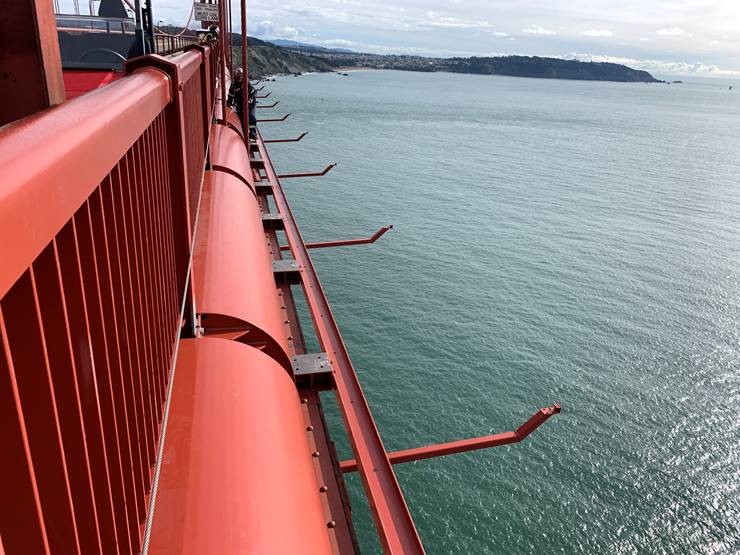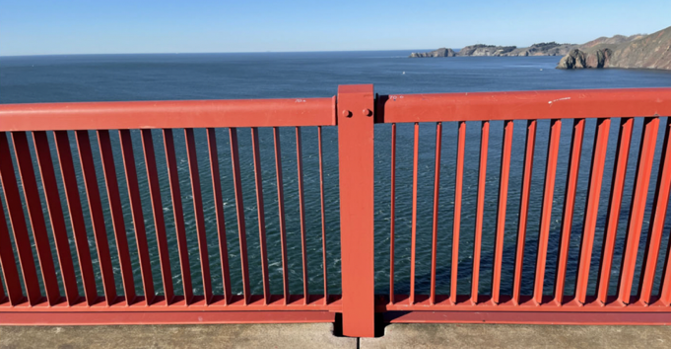
The Golden Gate Bridge District (District) is pleased to share a solution to reduce or eliminate the sounds that emanate from the Bridge during high wind events. The District Board of Directors approved an item at their meeting on December 17, 2021, to move forward with the solution and associated actions.
After extensive analysis and testing, the District has developed a cost-effective measure that will eliminate many of the wind-induced sounds altogether and make most remaining sounds inaudible. Tones may still be audible at the Bridge during rare instances of very specific and severe wind conditions, however the proposed solution was shown to reduce those sounds by 75% compared to railing without the solution installed. Any remaining sounds are expected to be faint or inaudible in residential areas near the Bridge and occur only several times per year, on average.
The proposed solution will be invisible to most Bridge users and, importantly, will not affect the Bridge’s structural stability during sustained high winds. Installation is expected to be complete in 2025.
Approved Design
The solution, designed by District engineers and leading bridge aerodynamics and acoustics experts, calls for installation of thin, u-shaped clips attached to both edges of all 12,000 vertical slats on the newly installed west railing. The clips, which are just 1/8 of an inch thick, will cover the edge of every slat from top to bottom and will include a thin rubber sleeve underneath to dampen vibrations that contribute to the sounds.

(Top-down illustration of the clips installed on the railing slats. Note: clips are not to scale and are represented larger for illustration purposes.)
The clips will be painted in the Golden Gate Bridge’s famous International Orange, making them invisible to most Bridge users. This design has been reviewed by architectural preservation experts who have confirmed that the clips will have no impact on the Bridge’s cherished architecture.

(Slats without clips are on the left, slats with clips installed shown on the right)
The u-shaped clips work to reduce or eliminate sounds by lightly disrupting the flow of air as it passes over each slat, minimizing “vortex shedding”, or the creation of small vibrations in the air. Sounds are created when these vibrations match the natural structural vibrations of the slats or of the air between the slats, which are then propagated in sound waves, similar to a cone speaker (a detailed discussion of the effect can be found on page 6 of the staff report.) By disrupting airflow, the u-shaped clips and rubber sleeves greatly reduce the vibrations in both the air and slats, thereby eliminating or reducing the sounds to mostly inaudible levels.
Project Cost and Timeline
The estimated cost to fabricate the clips and rubber inserts for the 12,000 affected slats is $450,000. Funding will come from the Bridge operating budget and will not require any additional revenue measures. Installation of the clips and inserts will be performed by Bridge staff as part of their regular maintenance activities. Installation is expected to be completed in 2025.
Results of Testing and Analysis
In July 2020, the Bridge District engaged the world’s foremost bridge aerodynamics and acoustics experts to better understand the source of the new sounds coming from the Golden Gate Bridge and to develop potential measures to dampen or eliminate them. First, the experts took sound camera measurements from the Bridge sidewalk during high wind events to record the new sound. These measurements confirmed that the sound is generated by sustained high winds passing through the new, more aerodynamic west railing.
Beginning in the fall of 2020, the District began conducting wind tunnel testing of a full-scale model of the railing. In the wind tunnel, engineers were able to recreate the noise in a controlled environment, allowing us to further pinpoint the mechanism of railing and wind interaction that creates the sound. Through these tests, we learned that there are two distinct sounds that occur under different wind conditions.
The first sound is a low-pitched and low-frequency tone (between 280-700Hz) that is present when wind passes perpendicularly to the railing (from the West) at wind speeds of 22mph or more. This lower-frequency tone is often heard furthest away from the Bridge. The second tone present during certain high winds is of a higher pitch and frequency (1.1kHz) and is present when wind passes the railing at a slight angle and with speeds of 27mph or more.
With an understanding of the source of the sounds and the specific conditions that create them, we developed several measures in partnership with our aerodynamics and acoustics experts to assess their feasibility for being installed on the Bridge without jeopardizing the aerodynamic quality of the new railing. These measures included: adding horizontal bars to the slats, adding coarse tape to the edges of the slats to disrupt airflow, placing thin u-shaped clips over the edges of the slats, adding textured paint to the sides of the slats, and filling the top of the rail with metal to increase its damping capacity.
After extensive testing of these measures, the u-shaped clips with a thin rubber insert performed the best at reducing or eliminating both tones without affecting the effectiveness of the new railing. In most instances, the clip design eliminated wind-induced sounds altogether or reduced the sounds to levels that would be inaudible at the Bridge. In rare instances where tones were audible, the clips reduced those sounds by 75% compared to railing without the clips installed.
The clip design was tested further in a wind tunnel under 110 different combinations of wind speed and direction, where it was shown to eliminate or make inaudible the sounds in all but two very specific and severe wind scenarios. Those conditions include wind speeds between 36-45mph with an angle of 40 degrees, which would create a high-frequency tone. The other wind combination created a low-frequency sound at a wind speed of 63mph with an angle perpendicular to the railing. Conditions that create the high-frequency tone are expected to occur an average of 70 hours per year, while conditions to create the low-frequency tone are expected to occur an average of 18 hours annually.
Based on study of the ambient sound in residential areas near the Bridge, both tones, should they occur, are likely to be inaudible to barely audible above background noise.
About the Golden Gate Bridge Wind Retrofit
In the spring of 2020, the District became aware of sounds coming from the Golden Gate Bridge during high winds. The sounds are the result of a confluence of sustained high winds passing at specific angles through the recently installed new west sidewalk Bridge railing. This new railing is part of the Bridge Wind Retrofit project.
The Wind Retrofit is necessary to ensure that the structural integrity of the Bridge is not jeopardized during high winds and will allow the Bridge to withstand extreme sustained winds up to 100 miles per hour. The construction of the Wind Retrofit is especially important in the context of increasing severe weather events due to climate change. The project is also essential for the completion of the Suicide Deterrent System, which will include netting along the length of both sides of the Bridge, further increasing wind resistance.
The Wind Retrofit involves the replacement of the existing Bridge railing on the west sidewalk between the two Suspension Bridge Main Towers with new railing that has thin vertical slats designed to allow more air to flow through the railing. The project also includes the installation of a wind fairing just below the sidewalk level on the outside of the Bridge truss.
To share your comments with the Golden Gate Bridge, Highway and Transportation District, please send an email to bridgecomments@goldengate.org.